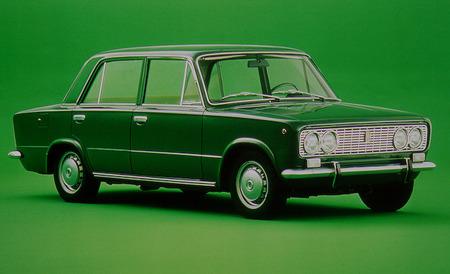Efficiency isn’t just confined to the heatÂer. You find sprinklings of it all around the interior. The backs of the comfortable bucket seats, for example, which recline in small increments until they are level with the cushions. And the storage compartments—a lidded but not lockable glove box in the dash, an open bin in each kick panel and a shelf in the console—which provide plenty of room for the trivia of travel. The convenience of the 124S has not been compromised to make a price.
And the lack of compromise extends to the mechanical 124S too. The front susÂpension is an unequal-length control arm system with coil springs very much like that on most American cars. This is in contrast to the MacPherson strut arrangeÂment which has become commonplace on small imported cars in the last few years. At the rear a solid axle is carefully posiÂtioned by four trailing arms and a Pan-hard rod. Vacuum-assisted disc brakes are used at all four wheels with a height/load sensing valve to proportion the rear wheels’ braking force. The sedan and the 124 Coupe and Spider all share the same brakÂing and suspension systems which should tell you about their effectiveness.
Considering the clue of 1438cc displaceÂment, common to both the 1245 sedan and the sports cars, you would be right in susÂpecting that engine parts are also shared. In fact, the basic engine including the bore and stroke is identical. The difference is that the sedan has a conventional overhead valve cylinder head with the camshaft in the block, while the sports cars have dual overhead cams. Each uses a 2-bbl. down-draft Weber carburetor and a smoothly contoured exhaust manifold with two outlet pipes which Y into one main pipe about two feet downstream from the manifold. Because of the 9.0-to-one compression ratio premium fuel is recommended for the seÂdan—a bit inconsistent with economy car practice. But for that matter so is the rated output of 76 horsepower at 5400 rpm—up from 65 hp at 5600 rpm the previous 124 sedan.
All of this extra horsepower notwithstanding, the 124S was actually slightly slower than the 124 sedan (a non-emission controlled model) that we tested in July of 1967. Quarter-mile elapsed time was the same for both at 19.5 seconds but the 124S cleared the traps at 66.3 mph, slower by 2.7 mph than the 124. Also, at 86 mph, the top speed of the 124S was 4 mph slower than the old 124. It’s discrepancies like this, bigger engines slowing the car down, that afflict road testers with excess stomach acid and throbbing tension centers. Fiat representatives dismiss it all with a wave of the hand saying, “What can you expect from a Fiat with only 550 miles on it?” They go on to explain that you have to have at least 2000 miles showing before the cars begin to show their true performance capabilities. Even so, the Fiat’s accelÂeration is still good, equal to the Datsun PL510 and significantly quicker than the VW’s, Simca’s and the Austin America’s.
The brakes also show a good account of themselves. The Fiat stopped in 198 feet (0.83G) from 70 mph which is in keeping with most economy cars, although the Datsun and the Simca 1204 did stop someÂwhat quicker. Stopping the Fiat is a very controllable operation. There was no noÂticeable fade in three stops and directional stability was very good. Like the 124 sports cars, however, the brakes do tend to squeak after they are broken in.
The most enjoyable of the driver’s tools in the 124S is the transmission. Because of the short, direct throws you can snap through the ratios with an ease that would embarrass all too many of the real sports cars. And with the Fiat’s handling you wouldn’t be left in the dust on winding roads either. The sedan is a strongly under-steering car but it has a moderate roll angle and very good cornering ability. A good bit of the latter must be credited to the Pirellis which are definitely a cut above the tires you normally find on economy cars.
And the sedan’s similarity to sports cars continues in some less fortunate ways. The ride tends to be harsh, particularly when the tires are inflated to the manufacturer’s recommended 24/28 psi settings. If you lower the pressure the steering effort, which is none too light to start out with, gets uncomfortably heavy. And all the time you have noise. The test car suffered a most depressing roaring-droning seizure in the 57-62 mph range. No problem at 50 and it was all gone at 70 but halfway between was to be diligently avoided. Engine noise, too, was conspicuous at all speeds as were other undefinable sounds. Still, nothing about the Fiat creates the impression of poor assembly or impending disaster. To the contrary, it feels bullet proof-like no amount of abuse would kill it. It substitutes a kind of fearlessness for the refineÂment and softness found in other economy cars like the Simca 1204 and the Datsun and the more expensive Fiat sports cars. The 124S is a car you can’t ignore.
Nor can you ignore Fiat itself—a self-proclaimed malcontent car company that is out to better its position in this world by whatever means required. Volkswagen is obviously on the crosshairs. Fiat has cut its prices in Germany to put the hurt on Wolfsburg and the 124S is being sent to the U.S. in preparation for battle with the XP-887, Ford’s Phoenix and American Motors’ Gremlin, or whatever it will be called. At this point the winning combination is known only to the Fates.
If it turns out that a hard-nosed little car with a healthy capacity for work is just what dollar-conscience America has been waiting for, you can expect yet another conquest from Fiat.


Leave a Reply